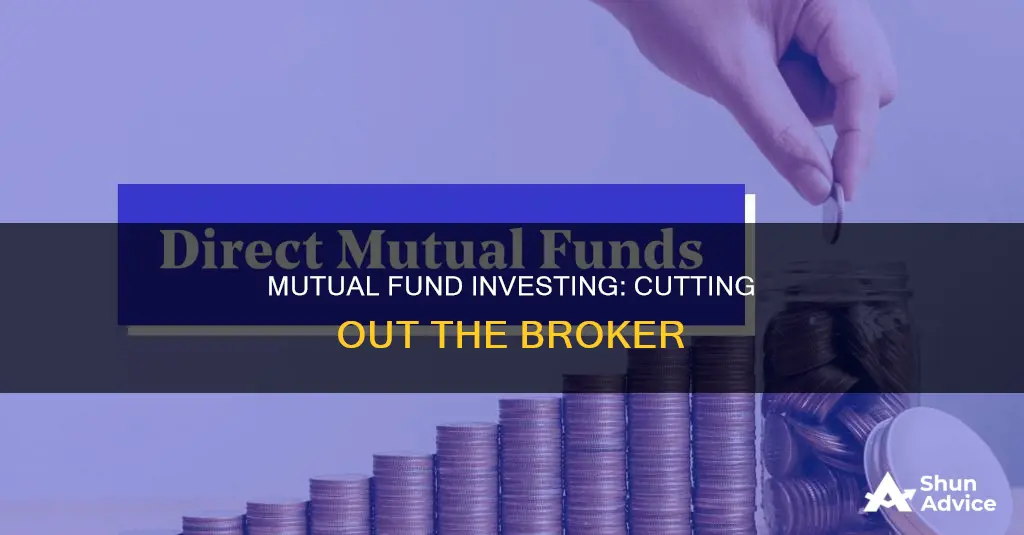
Investing in mutual funds can be a rewarding step towards financial growth and independence. By choosing to invest directly in mutual funds, investors can bypass intermediary commissions and potentially increase their returns. This approach offers greater control and transparency over one's investment portfolio. There are two primary modes of investing in direct mutual funds: offline and online. The offline method involves physically visiting the office of the Asset Management Company (AMC) or a registrar, completing the Know Your Customer (KYC) process, submitting the necessary documents, and making the investment. On the other hand, the online method offers a more convenient approach by allowing investors to invest through the AMC or Mutual Fund Company's website or a Registrar and Transfer Agent (R&TA). This method also requires completing the KYC process and linking bank accounts for investments and redemption proceeds. Both methods empower investors to make informed decisions, monitor their portfolios, and work towards their financial goals.
| Characteristics | Values |
|---|---|
| Investment Methods | Online and Offline |
| Online Platforms | Asset Management Company (AMC) Website, Registrar and Transfer Agent (RTA) Website, Mutual Fund Distributor's Website, Stock Broker, Bank, Mobile App |
| Online Requirements | KYC Compliance, PAN Card, Bank Account |
| Offline Requirements | Physical Visit to AMC or RTA Office, KYC Compliance, PAN Card, Address Proof, Common Application Form or SIP Form, Cheque or Demand Draft |
| Investment Types | Systematic Investment Plan (SIP), Lump Sum |
What You'll Learn

Complete the KYC process
Completing the KYC (Know Your Customer) process is a crucial step in investing in mutual funds, as it helps prevent money laundering, fraud, and criminal activities. Here is a detailed guide on how to complete the KYC process:
Understand the Requirements:
Know the documents you need to provide. This typically includes a PAN card, which is mandatory, and address proof such as an Aadhar Card, Driving License, or Voter ID. Some sources also mention the need for a photograph and in-person verification.
Choose the KYC Method:
You can complete the KYC process offline or online. The offline method involves downloading and printing the KYC form from the CSDL website or obtaining it from your chosen fund house or investment platform. The online method can be done through the website of any KRA (KYC Registration Agency) and offers a more convenient, paperless process.
Fill Out the Form:
If you opt for the offline method, fill out the KYC form and attach copies of the required documents, ensuring that they are self-attested. If you choose the online method, create an account on the KRA website, fill out the online form, and upload the required documents.
Submit the Form and Documents:
For the offline method, submit the completed KYC application form and supporting documents at the KRA office or the fund house's office. For the online method, simply submit the form and documents electronically.
Receive KYC Identification Number:
Once your KYC process is complete, you will be provided with a KYC identification number. This number can be shared with the mutual fund house or intermediary you plan to invest with.
Additional Tips:
- The Aadhar card is not compulsory for KYC, but it offers a more straightforward process and is preferred by many investors.
- If you are investing for the first time, you cannot complete the KYC process first and then invest in a mutual fund at a later date. The KYC application must be accompanied by a mutual fund transaction form.
- If you choose the online method with Aadhaar-based eKYC, there is a limit of Rs. 50,000 per fund house each year. For higher investment amounts, you will need to do the physical KYC or a biometric KYC.
By following these steps, you can complete the KYC process, which is a crucial prerequisite to investing directly in mutual funds without a broker.
Mutual Funds: Diversify Your Portfolio, Maximize Returns
You may want to see also

Choose a platform
You can choose to invest in mutual funds either offline or online. If you choose the offline method, you will need to physically visit the nearest office of the Asset Management Company (AMC) whose fund you have selected. You can also visit the local Registrar and Transfer Agent (RTA) office. At the AMC or RTA office, you will be asked to complete your Know Your Customer (KYC) process if you are not already compliant.
If you choose the online method, you can invest in mutual funds through the AMC or RTA website, or through a fintech platform. Investing directly on a fund's website may require you to manage multiple logins. Online platforms generally offer various payment options, including net banking, UPI, and debit cards.
Before choosing a platform, ensure that it is user-friendly and provides the necessary information. You should also make sure that the platform offers the specific mutual fund scheme in which you want to invest.
Popular platforms known for facilitating direct mutual fund investments include Kuvera, Groww, Zerodha Coin, ET Money, Paytm Money, and ICICI Direct. Each platform offers unique features and user experiences, so it is important to consider factors such as user interface, fees, and alignment with your financial goals when making your decision.
Mutual Funds Backing AMD: Who's Investing in the Tech Giant?
You may want to see also

Registration
Choose a Platform:
Select a reputable online mutual fund app or a fund house's website that offers direct mutual fund investments. Look for a user-friendly platform that provides all the necessary information to make informed investment decisions. This includes details about the fund's performance, fees, and investment strategy. Ensure you understand the platform's registration process, as it may vary from one provider to another.
Create an Account:
Once you've chosen a platform, create an account by providing your personal details, such as your name, email address, and mobile number. You will also need to provide your Know Your Customer (KYC) information, which includes proof of identity and address. A PAN card, Aadhar card, passport, or other government-issued ID are typically accepted as valid forms of identification. Some platforms may offer paperless registration or Aadhar-based e-KYC for faster and more convenient sign-up.
Link Your Bank Account:
Linking your bank account is an essential step in the registration process. This allows you to seamlessly invest money and receive redemption proceeds. You will need to provide your account number, IFSC code, and other relevant details. Some platforms may also require you to verify your bank account by making a small test deposit or providing a cancelled cheque.
Complete the KYC Process:
Submit the necessary documents to complete your KYC process. This may include submitting a copy of your PAN card, Aadhar card or other address proof, and a recent passport-sized photograph. The KYC process is a one-time requirement and is essential for regulatory compliance. It helps verify your identity and ensures that you are eligible to invest in mutual funds.
Explore Mutual Fund Options:
After completing your registration, take some time to browse through the available direct mutual funds on the platform. Evaluate their past performance, fund manager expertise, expense ratios, and investment strategies. This information will help you make informed decisions about which funds align with your financial goals, risk tolerance, and investment horizon.
Remember to review the registration requirements and instructions provided by the platform you choose, as there may be slight variations in the process. Always ensure that you understand the risks involved and seek independent financial advice if needed before making any investment decisions.
Hedge Funds: Risky Business and Unnecessary Investment
You may want to see also

Link your bank account
Linking your bank account is a crucial step in the process of investing in direct mutual funds. This step ensures that you can seamlessly invest money and receive redemption proceeds. Here's a detailed guide on linking your bank account:
Provide Bank Account Information:
When registering on the chosen platform or creating an account with the Asset Management Company (AMC), you will be required to provide your bank account details. This includes your account number, IFSC code, and account type. Ensure that the information you provide is accurate to avoid any issues during transactions.
Verification and Confirmation:
After entering your bank account details, it's important to verify and confirm the information. Double-check that all the details are correct, including your name, bank name, account number, and IFSC code. Some platforms or AMCs may send a One-Time Password (OTP) to your registered mobile number or email address for added security and verification.
Linking Process:
The specific steps for linking your bank account may vary depending on the platform or AMC you are using. Generally, you will need to follow the instructions provided by the platform or AMC. This may involve submitting a request to link your bank account or providing additional documentation for verification purposes. Make sure to follow the linking process carefully to ensure a successful linkage.
Security and Privacy:
When linking your bank account, it's essential to prioritize security and privacy. Ensure that you are using a secure and reputable platform or AMC website. Look for security features such as encryption and two-factor authentication to protect your sensitive financial information. Avoid providing your bank account details on unsecured or untrusted websites.
Test Transaction:
Once your bank account is linked, consider making a small test transaction to ensure that everything is functioning correctly. This can help you verify that your bank account is properly linked and that transactions can be processed smoothly. Start with a minimal amount and monitor your account to confirm that the transaction goes through as expected.
By following these steps, you can successfully link your bank account when investing in direct mutual funds. Remember to always review the specific instructions and requirements provided by the platform or AMC you choose for your investments.
Property Funds: A Smart Investment Strategy for Diversification
You may want to see also

Explore mutual funds
Once you have chosen a platform, registered, and completed the KYC process, you can start exploring the available mutual funds. This is a crucial step, as it involves evaluating different funds to make an informed decision. Here are some key factors to consider:
- Past Performance: Review the historical performance of the mutual fund. Look at its returns over different periods to gauge its consistency and identify any notable trends.
- Fund Manager Expertise: Assess the qualifications, experience, and track record of the fund manager responsible for making investment decisions. A competent and experienced fund manager can positively impact the fund's performance.
- Expense Ratio: The expense ratio represents the fund's operating expenses, expressed as a percentage of its average net assets. A lower expense ratio means that a more considerable portion of the fund's returns is passed on to investors.
- Investment Strategy: Understand the fund's investment strategy, including the types of securities it invests in, its level of risk, and how actively it is managed. Ensure the strategy aligns with your financial goals and risk tolerance.
- Risk Tolerance: Different mutual funds carry varying levels of risk. Consider your own risk tolerance and choose funds that match your comfort level. Remember that higher-risk funds may offer the potential for higher returns but also carry a greater chance of loss.
- Diversification: Diversification across different asset classes, sectors, and industries can help reduce risk. Look for funds that offer a well-diversified portfolio to minimise the impact of any single investment on the overall performance.
- Performance Benchmarks: Compare the fund's performance against relevant benchmarks to evaluate its relative returns. This can help you identify funds that consistently outperform or underperform the market.
- Fund Size: The size of the fund can impact its performance and flexibility. Larger funds may have more negotiating power and access to certain investments, while smaller funds may be more agile and able to capitalise on opportunities faster.
- Fund Ratings: Independent ratings agencies assess and rate mutual funds based on their performance, risk, and other factors. While ratings are not a sole indicator of a fund's quality, they can provide additional insight.
Remember that investing in mutual funds involves risk, and past performance does not guarantee future results. It is essential to consider your financial goals, risk tolerance, and investment horizon when evaluating mutual funds. Diversification and long-term investing are generally considered prudent strategies for managing risk and pursuing financial goals.
Mutual Funds: A Smart Investment Strategy?
You may want to see also
Frequently asked questions
You can invest directly in a Mutual Fund either offline or online. If you are uncomfortable with online transactions, you can visit the nearest branch of the fund house. However, investing online is more convenient and saves on commissions.
First, choose a Mutual Fund Scheme and then visit its official website. Next, open an account with the Asset Management Company (AMC) and select "Direct" under the "Plan Type" option. After that, choose your investment details, including the Systematic Investment Plan or lump-sum option, and confirm your bank details. Verify the details, make the necessary payment, and you will receive a confirmation.
To invest in mutual funds, you need to be Know Your Client (KYC) compliant. This typically includes a recent passport-size photograph, proof of identity (such as a passport or PAN card), a copy of your PAN card, and proof of address (such as an Aadhaar card).
Investing in direct mutual funds offers several advantages, including cost savings due to lower expense ratios, the potential for higher returns, ease of online transactions, and greater flexibility and control over investment decisions.







